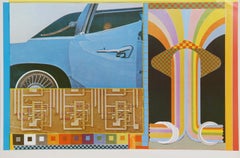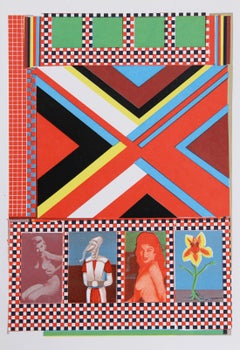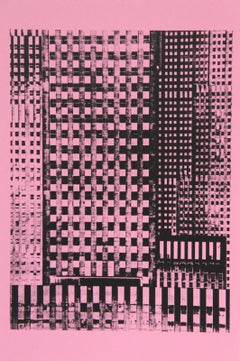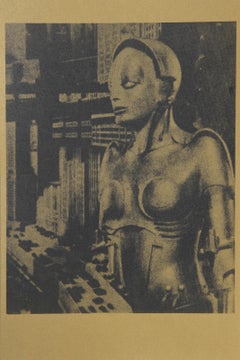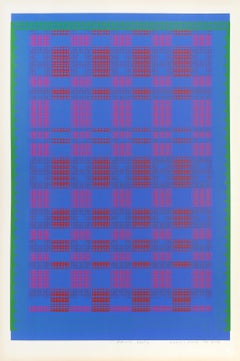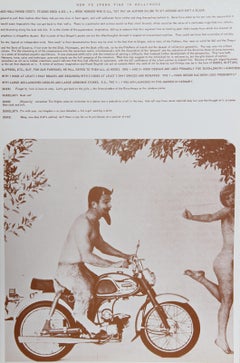Eduardo Paolozzi Abstract Prints
British, 1924-2005
Eduardo Paolozzi (1924 – 2005) was a prolific and inventive Scottish artist most known for his marriage of Surrealism's early principles with brave new elements of popular culture, modern machinery and technology. He was raised in the shadows of World War II in a family deeply affected by the divisive nature of a country involved in conflict, which birthed his lifelong exploration into the many ways humans are influenced by external, uncontrollable forces.
This exploration would come to inform a vast and various body of work that vacillated between the darker and lighter consequences of society's advancements and its so-called progress. His collages reflect the way contemporary culture and mass media influenced individual identity. Some of these, with their appropriation of American advertising's look and feel would inspire the future Pop art movement.to
47
2
2
1
Overall Width
to
Overall Height
to
52
66
637
205
165
164
52
3
49
46
6
46
6
3
48
52
Artist: Eduardo Paolozzi
Totems and Taboos of the Nine to Five Day, Pop Art Lithograph by Paolozzi
By Eduardo Paolozzi
Located in Long Island City, NY
Eduardo Paolozzi, British (1924 - 2005) - Totems and Taboos of the Nine to Five Day, Portfolio: General Dynamic F.U.N. Portfolio, Year: 1970, Medium: Photolithograph, signed and numb...
Category
1970s Pop Art Eduardo Paolozzi Abstract Prints
Materials
Lithograph
Part One, Frozen Terror...Part Two, Pop Art Lithograph by Eduardo Paolozzi
By Eduardo Paolozzi
Located in Long Island City, NY
Eduardo Paolozzi, British (1924 - 2005) - Part One, Frozen Terror...Part Two, Fangs of Death, Portfolio: General Dynamic F.U.N. Portfolio, Year: 1970, Medium: Photolithograph, stamp ...
Category
1970s Pop Art Eduardo Paolozzi Abstract Prints
Materials
Lithograph
Notes on Organisation of Paradise, Pop Art Lithograph by Eduardo Paolozzi
By Eduardo Paolozzi
Located in Long Island City, NY
Eduardo Paolozzi, British (1924 - 2005) - Notes on Organisation of Paradise, Portfolio: General Dynamic F.U.N. Portfolio, Year: 1970, Medium: Photolithograph, stamp signed verso, Edi...
Category
1970s Pop Art Eduardo Paolozzi Abstract Prints
Materials
Lithograph
Twenty Traumatic Twinges, Pop Art Lithograph by Eduardo Paolozzi
By Eduardo Paolozzi
Located in Long Island City, NY
Eduardo Paolozzi, British (1924 - 2005) - Twenty Traumatic Twinges, Portfolio: General Dynamic F.U.N. Portfolio, Year: 1970, Medium: Photolithograph, stamp signed verso, Edition: 350...
Category
1970s Pop Art Eduardo Paolozzi Abstract Prints
Materials
Lithograph
Memory Matrix, Pop Art Screenprint by Eduardo Paolozzi
By Eduardo Paolozzi
Located in Long Island City, NY
Eduardo Paolozzi, British (1924 - 2005) - Memory Matrix, Year: circa 1968, Medium: Screenprint, signed and numbered in pencil, Edition: AP 9, Image Size: 36 x 24 inches, Size: 40 x 2...
Category
1970s Pop Art Eduardo Paolozzi Abstract Prints
Materials
Screen
How to Spend Time in Hollywood II, Pop Art Lithograph by Eduardo Paolozzi
By Eduardo Paolozzi
Located in Long Island City, NY
Eduardo Paolozzi, British (1924 - 2005) - How to Spend Time in Hollywood II, Portfolio: General Dynamic F.U.N. Portfolio, Year: 1970, Medium: Photolithograph, stamp signed verso, Edi...
Category
1970s Pop Art Eduardo Paolozzi Abstract Prints
Materials
Lithograph
What are the Building Blocks of Structuralism? I, Pop Art Lithograph by Paolozzi
By Eduardo Paolozzi
Located in Long Island City, NY
Eduardo Paolozzi, British (1924 - 2005) - Inside Down Under... What are the Building Blocks of Structuralism? I, Portfolio: General Dynamic F.U.N. Portfolio, Year: 1970, Medium: Phot...
Category
1970s Pop Art Eduardo Paolozzi Abstract Prints
Materials
Lithograph
Studies in Human Salvage, Pop Art Lithograph by Eduardo Paolozzi
By Eduardo Paolozzi
Located in Long Island City, NY
Eduardo Paolozzi, British (1924 - 2005) - Studies in Human Salvage, Portfolio: General Dynamic F.U.N. Portfolio, Year: 1970, Medium: Photolithograph, stamp signed verso, Edition: 350...
Category
1970s Pop Art Eduardo Paolozzi Abstract Prints
Materials
Lithograph
Hero as a Riddle by Eduardo Paolozzi gold silver pop art with Basquiat style
By Eduardo Paolozzi
Located in New York, NY
Hero as a Riddle (1963) depicts a smiling head printed in gold, silver, and black. The shapes and lines composing the figure’s face are architectural and geometric: the eyes are comp...
Category
1960s Pop Art Eduardo Paolozzi Abstract Prints
Materials
Screen
Tafel 16 by Eduardo Paolozzi colorful geometric collage pop art striped optical
By Eduardo Paolozzi
Located in New York, NY
This Eduardo Paolozzi screenprint is composed with primary colors and black and white photographic imagery “collaged” in. Stripes and curvilinear forms merge in a vibrant exemplar of...
Category
1960s Pop Art Eduardo Paolozzi Abstract Prints
Materials
Screen
Animals vs. Aliens, Pop Art Lithograph by Eduardo Paolozzi
By Eduardo Paolozzi
Located in Long Island City, NY
Eduardo Paolozzi, British (1924 - 2005) - Animals vs. Aliens, Portfolio: General Dynamic F.U.N. Portfolio, Year: 1970, Medium: Photolithograph, stamp signed verso, Edition: 350, Size...
Category
1970s Pop Art Eduardo Paolozzi Abstract Prints
Materials
Lithograph
Synthetic Sirens in Pink Light District, Pop Art Lithograph by Eduardo Paolozzi
By Eduardo Paolozzi
Located in Long Island City, NY
Eduardo Paolozzi, British (1924 - 2005) - Synthetic Sirens in Pink Light District, Portfolio: General Dynamic F.U.N. Portfolio, Year: 1970, Medium: Photolithograph, stamp signed vers...
Category
1970s Pop Art Eduardo Paolozzi Abstract Prints
Materials
Lithograph
Early Mental of 300 Geniuses, Pop Art Lithograph by Eduardo Paolozzi
By Eduardo Paolozzi
Located in Long Island City, NY
Eduardo Paolozzi, British (1924 - 2005) - Early Mental of 300 Geniuses, Portfolio: General Dynamic F.U.N. Portfolio, Year: 1970, Medium: Photolithograph, stamp signed verso, Edition:...
Category
1970s Pop Art Eduardo Paolozzi Abstract Prints
Materials
Lithograph
The Impossible Dream it's all the Same, Pop Art Lithograph by Eduardo Paolozzi
By Eduardo Paolozzi
Located in Long Island City, NY
Eduardo Paolozzi, British (1924 - 2005) - The Impossible Dream it's all the Same, Portfolio: General Dynamic F.U.N. Portfolio, Year: 1970, Medium: Photolithograph, stamp signed verso...
Category
1970s Pop Art Eduardo Paolozzi Abstract Prints
Materials
Lithograph
War Games Revised, Pop Art Screenprint by Eduardo Paolozzi
By Eduardo Paolozzi
Located in Long Island City, NY
Eduardo Paolozzi, British (1924 - 2005) - War Games Revised, Year: circa 1968, Medium: Screenprint, signed and numbered in pencil, Edition: 68/75, Image Size: 34 x 24 inches, Size: 4...
Category
1970s Pop Art Eduardo Paolozzi Abstract Prints
Materials
Screen
Untitled - Optical Grid, Pop Art Lithograph by Eduardo Paolozzi
By Eduardo Paolozzi
Located in Long Island City, NY
Eduardo Paolozzi, British (1924 - 2005) - Untitled - Optical Grid, Portfolio: General Dynamic F.U.N. Portfolio, Year: 1970, Medium: Lithograph, Size: 8 x 5.75 in. (20.32 x 14.61 cm)
Category
1970s Pop Art Eduardo Paolozzi Abstract Prints
Materials
Lithograph
What are the Building Blocks of Structuralism?, Pop Art Screenprint by Paolozzi
By Eduardo Paolozzi
Located in Long Island City, NY
Eduardo Paolozzi, British (1924 - 2005) - Inside Down Under... What are the Building Blocks of Structuralism? I, Portfolio: General Dynamic F.U.N. Portfolio, Year: 1970, Medium: Scre...
Category
1970s Pop Art Eduardo Paolozzi Abstract Prints
Materials
Screen
Temporary Variations in Experienced Type II, Pop Art Lithograph by Paolozzi
By Eduardo Paolozzi
Located in Long Island City, NY
Eduardo Paolozzi, British (1924 - 2005) - Temporary Variations in Experienced Type II, Portfolio: General Dynamic F.U.N. Portfolio, Year: 1970, Medium: Photolithograph, stamp signed ...
Category
1970s Pop Art Eduardo Paolozzi Abstract Prints
Materials
Lithograph
Risk-Taking as a Function of the Situation, Pop Art Lithograph by Paolozzi
By Eduardo Paolozzi
Located in Long Island City, NY
Eduardo Paolozzi, British (1924 - 2005) - Risk-Taking as a Function of the Situation, Portfolio: General Dynamic F.U.N. Portfolio, Year: 1970, Medium: Photolithograph, stamp signed v...
Category
1970s Pop Art Eduardo Paolozzi Abstract Prints
Materials
Lithograph
Brainiacs 5 No Puede Ganar Contra Tres Marquinas, Pop Art Lithograph by Paolozzi
By Eduardo Paolozzi
Located in Long Island City, NY
Eduardo Paolozzi, British (1924 - 2005) - Brainiacs 5 No Puede Ganar Contra Tres Marquinas, Portfolio: General Dynamic F.U.N. Portfolio, Year: 1970, Medium: Photolithograph, stamp si...
Category
1970s Pop Art Eduardo Paolozzi Abstract Prints
Materials
Lithograph
59 Varieties of Paradise, Pop Art Lithograph by Eduardo Paolozzi
By Eduardo Paolozzi
Located in Long Island City, NY
Eduardo Paolozzi, British (1924 - 2005) - 59 Varieties of Paradise, Portfolio: General Dynamic F.U.N. Portfolio, Year: 1970, Medium: Photolithograph, stamp signed verso, Edition: 350...
Category
1970s Pop Art Eduardo Paolozzi Abstract Prints
Materials
Lithograph
The Accident Syndrome the Genesis of Injury, Pop Art Lithograph by Paolozzi
By Eduardo Paolozzi
Located in Long Island City, NY
Eduardo Paolozzi, British (1924 - 2005) - The Accident Syndrome the Genesis of Injury, Portfolio: General Dynamic F.U.N. Portfolio, Year: 1970, Medium: Photolithograph, stamp signed ...
Category
1970s Pop Art Eduardo Paolozzi Abstract Prints
Materials
Lithograph
Cary Grant as a Male War Bride, Pop Art Lithograph by Eduardo Paolozzi
By Eduardo Paolozzi
Located in Long Island City, NY
Eduardo Paolozzi, British (1924 - 2005) - Cary Grant as a Male War Bride, Portfolio: General Dynamic F.U.N. Portfolio, Year: 1970, Medium: Photolithograph, stamp signed verso, Editio...
Category
1970s Pop Art Eduardo Paolozzi Abstract Prints
Materials
Lithograph
Cucumber Night Cream, Pop Art Lithograph by Eduardo Paolozzi
By Eduardo Paolozzi
Located in Long Island City, NY
Eduardo Paolozzi, British (1924 - 2005) - Cucumber Night Cream, Portfolio: General Dynamic F.U.N. Portfolio, Year: 1970, Medium: Photolithograph, stamp signed verso, Edition: 350, Si...
Category
1970s Pop Art Eduardo Paolozzi Abstract Prints
Materials
Lithograph
Pig or Person, it's the Same, Fortune Plays II, Pop Art Lithograph by Paolozzi
By Eduardo Paolozzi
Located in Long Island City, NY
Eduardo Paolozzi, British (1924 - 2005) - Pig or Person, it's the Same, Fortune Plays a Funny Game II, Portfolio: General Dynamic F.U.N. Portfolio, Year: 1970, Medium: Photolithograp...
Category
1970s Pop Art Eduardo Paolozzi Abstract Prints
Materials
Lithograph
The Puzzle of Female Pleasure, Pop Art Lithograph by Eduardo Paolozzi
By Eduardo Paolozzi
Located in Long Island City, NY
Eduardo Paolozzi, British (1924 - 2005) - The Puzzle of Female Pleasure, Portfolio: General Dynamic F.U.N. Portfolio, Year: 1970, Medium: Photolithograph, stamp signed verso, Edition...
Category
1970s Pop Art Eduardo Paolozzi Abstract Prints
Materials
Lithograph
Careers Today... How Children Fail, Pop Art Lithograph by Eduardo Paolozzi
By Eduardo Paolozzi
Located in Long Island City, NY
Eduardo Paolozzi, British (1924 - 2005) - Careers Today... How Children Fail, Portfolio: General Dynamic F.U.N. Portfolio, Year: 1970, Medium: Photolithograph, stamp signed verso, Ed...
Category
1970s Pop Art Eduardo Paolozzi Abstract Prints
Materials
Lithograph
...Read Next Month's Issue, Pop Art Lithograph by Eduardo Paolozzi
By Eduardo Paolozzi
Located in Long Island City, NY
Eduardo Paolozzi, British (1924 - 2005) - Why Children Commit Suicide...Read Next Month's Issue, Portfolio: General Dynamic F.U.N. Portfolio, Year: 1970, Medium: Photolithograph, Edi...
Category
1970s Pop Art Eduardo Paolozzi Abstract Prints
Materials
Lithograph
Transparant Creatures Hunting New Victims, Pop Art Lithograph by Paolozzi
By Eduardo Paolozzi
Located in Long Island City, NY
Eduardo Paolozzi, British (1924 - 2005) - Transparant Creatures Hunting New Victims, Portfolio: General Dynamic F.U.N. Portfolio, Year: 1970, Medium: Photolithograph with Acetate Ove...
Category
1970s Pop Art Eduardo Paolozzi Abstract Prints
Materials
Lithograph
The Ritual Main Spring of the Area's Culture, Pop Art Lithograph by Paolozzi
By Eduardo Paolozzi
Located in Long Island City, NY
Eduardo Paolozzi, British (1924 - 2005) - The Ritual Main Spring of the Area's Culture, Portfolio: General Dynamic F.U.N. Portfolio, Year: 1970, Medium: Photolithograph, stamp signed...
Category
1970s Pop Art Eduardo Paolozzi Abstract Prints
Materials
Lithograph
Temporary Variations in Experienced Type, Pop Art Lithograph by Eduardo Paolozzi
By Eduardo Paolozzi
Located in Long Island City, NY
Eduardo Paolozzi, British (1924 - 2005) - Temporary Variations in Experienced Type, Portfolio: General Dynamic F.U.N. Portfolio, Year: 1970, Medium: Photolithograph, stamp signed ver...
Category
1970s Pop Art Eduardo Paolozzi Abstract Prints
Materials
Lithograph
Synthetic Sirens in Pink Light District (Orange), Pop Art Lithograph by Paolozzi
By Eduardo Paolozzi
Located in Long Island City, NY
Eduardo Paolozzi, British (1924 - 2005) - Synthetic Sirens in Pink Light District (Orange), Portfolio: General Dynamic F.U.N. Portfolio, Year: 1970, Medium: Photolithograph, stamp si...
Category
1970s Pop Art Eduardo Paolozzi Abstract Prints
Materials
Lithograph
Smash Hit, Good Loving, Plus..., Pop Art Lithograph by Eduardo Paolozzi
By Eduardo Paolozzi
Located in Long Island City, NY
Eduardo Paolozzi, British (1924 - 2005) - Smash Hit, Good Loving, Plus Like a Rolling Stone, Slow Down, etc., Portfolio: General Dynamic F.U.N. Portfolio, Year: 1970, Medium: Photoli...
Category
1970s Pop Art Eduardo Paolozzi Abstract Prints
Materials
Lithograph
Six Miles over Vacation-Land II (Pink), Pop Art Lithograph by Eduardo Paolozzi
By Eduardo Paolozzi
Located in Long Island City, NY
Eduardo Paolozzi, British (1924 - 2005) - Six Miles over Vacation-Land II (Pink), Portfolio: General Dynamic F.U.N. Portfolio, Year: 1970, Medium: Photolithograph, stamp signed verso...
Category
1970s Pop Art Eduardo Paolozzi Abstract Prints
Materials
Lithograph
Ready to Sparkle Fashion II, Pop Art Lithograph by Eduardo Paolozzi
By Eduardo Paolozzi
Located in Long Island City, NY
Eduardo Paolozzi, British (1924 - 2005) - Ready to Sparkle Fashion II, Portfolio: General Dynamic F.U.N. Portfolio, Year: 1970, Medium: Photolithograph, stamp signed verso, Edition: ...
Category
1970s Pop Art Eduardo Paolozzi Abstract Prints
Materials
Lithograph
Ready to Sparkle Fashion I, Pop Art Lithograph by Eduardo Paolozzi
By Eduardo Paolozzi
Located in Long Island City, NY
Eduardo Paolozzi, British (1924 - 2005) - Ready to Sparkle Fashion I, Portfolio: General Dynamic F.U.N. Portfolio, Year: 1970, Medium: Photolithograph, stamp signed verso, Edition: 3...
Category
1970s Pop Art Eduardo Paolozzi Abstract Prints
Materials
Lithograph
Plate Interpreted as a Whole (Whole Answer), Pop Art Lithograph by Paolozzi
By Eduardo Paolozzi
Located in Long Island City, NY
Eduardo Paolozzi, British (1924 - 2005) - Plate Interpreted as a Whole (Whole Answer), Portfolio: General Dynamic F.U.N. Portfolio, Year: 1970, Medium: Photolithograph, stamp signed ...
Category
1970s Pop Art Eduardo Paolozzi Abstract Prints
Materials
Lithograph
Pig or Person, It's the Same, Fortune Plays, Pholithograph by Eduardo Paolozzi
By Eduardo Paolozzi
Located in Long Island City, NY
Eduardo Paolozzi, British (1924 - 2005) - Pig or Person, It's the Same, Fortune Plays a Funny Game, Portfolio: General Dynamic F.U.N. Portfolio, Year: 1970, Medium: Pholithograph, Ed...
Category
1970s Pop Art Eduardo Paolozzi Abstract Prints
Materials
Lithograph
New Semester Reward of the Opressed, Pop Art Lithograph by Eduardo Paolozzi
By Eduardo Paolozzi
Located in Long Island City, NY
Eduardo Paolozzi, British (1924 - 2005) - New Semester Reward of the Opressed, Portfolio: General Dynamic F.U.N. Portfolio, Year: 1970, Medium: Photolithograph, stamp signed verso, E...
Category
1970s Pop Art Eduardo Paolozzi Abstract Prints
Materials
Lithograph
Mumblind and Munching to Muzak, Pop Art Lithograph by Eduardo Paolozzi
By Eduardo Paolozzi
Located in Long Island City, NY
Eduardo Paolozzi, British (1924 - 2005) - Mumblind and Munching to Muzak, Portfolio: General Dynamic F.U.N. Portfolio, Year: 1970, Medium: Photolithograph, stamp signed verso, Editio...
Category
1970s Pop Art Eduardo Paolozzi Abstract Prints
Materials
Lithograph
How to Spend Time in Hollywood, Pop Art Lithograph by Eduardo Paolozzi
By Eduardo Paolozzi
Located in Long Island City, NY
Eduardo Paolozzi, British (1924 - 2005) - How to Spend Time in Hollywood, Portfolio: General Dynamic F.U.N. Portfolio, Year: 1970, Medium: Photolithograph, stamp signed verso, Editio...
Category
1970s Pop Art Eduardo Paolozzi Abstract Prints
Materials
Lithograph
Hermaphrodite Children from Transvestite Parents, Pop Art Lithograph by Paolozzi
By Eduardo Paolozzi
Located in Long Island City, NY
Eduardo Paolozzi, British (1924 - 2005) - Hermaphrodite Children from Transvestite Parents, Portfolio: General Dynamic F.U.N. Portfolio, Year: 1970, Medium: Photolithograph, stamp si...
Category
1970s Pop Art Eduardo Paolozzi Abstract Prints
Materials
Lithograph
Fortunes Guide to Government Contracts, Pop Art Lithograph by Eduardo Paolozzi
By Eduardo Paolozzi
Located in Long Island City, NY
Eduardo Paolozzi, British (1924 - 2005) - Fortunes Guide to Government Contracts, Portfolio: General Dynamic F.U.N. Portfolio, Year: 1970, Medium: Photolithograph, stamp signed verso...
Category
1970s Pop Art Eduardo Paolozzi Abstract Prints
Materials
Lithograph
Early Mental Traits of 300 Geniuses II, Pop Art Lithograph by Eduardo Paolozzi
By Eduardo Paolozzi
Located in Long Island City, NY
Eduardo Paolozzi, British (1924 - 2005) - Early Mental Traits of 300 Geniuses II, Portfolio: General Dynamic F.U.N. Portfolio, Year: 1970, Medium: Photolithograph, stamp signed verso...
Category
1970s Pop Art Eduardo Paolozzi Abstract Prints
Materials
Lithograph
Comparative Research in Inexperienced Types, Pop Art Lithograph by Paolozzi
By Eduardo Paolozzi
Located in Long Island City, NY
Eduardo Paolozzi, British (1924 - 2005) - Comparative Research in Inexperienced Types, Portfolio: General Dynamic F.U.N. Portfolio, Year: 1970, Medium: Photolithograph, stamp signed ...
Category
1970s Pop Art Eduardo Paolozzi Abstract Prints
Materials
Lithograph
Careers Today... How Children Fail II, Pop Art Lithograph by Eduardo Paolozzi
By Eduardo Paolozzi
Located in Long Island City, NY
Eduardo Paolozzi, British (1924 - 2005) - Careers Today... How Children Fail II, Portfolio: General Dynamic F.U.N. Portfolio, Year: 1970, Medium: Photolithograph, stamp signed verso,...
Category
1970s Pop Art Eduardo Paolozzi Abstract Prints
Materials
Lithograph
Astute Sizing Up Perfume Trends, Pop Art Lithograph by Eduardo Paolozzi
By Eduardo Paolozzi
Located in Long Island City, NY
Eduardo Paolozzi, British (1924 - 2005) - Astute Sizing Up Perfume Trends, Portfolio: General Dynamic F.U.N. Portfolio, Year: 1970, Medium: Photolithograph, stamp signed verso, Editi...
Category
1970s Pop Art Eduardo Paolozzi Abstract Prints
Materials
Lithograph
Almost Any Suburb, Pop Art Lithograph by Eduardo Paolozzi
By Eduardo Paolozzi
Located in Long Island City, NY
Eduardo Paolozzi, British (1924 - 2005) - Almost Any Suburb, Portfolio: General Dynamic F.U.N. Portfolio, Year: 1970, Medium: Photolithograph, stamp signed verso, Edition: 350, Size:...
Category
1970s Pop Art Eduardo Paolozzi Abstract Prints
Materials
Lithograph
Almost Any Suburb II, Pop Art Lithograph by Eduardo Paolozzi
By Eduardo Paolozzi
Located in Long Island City, NY
Eduardo Paolozzi, British (1924 - 2005) - Almost Any Suburb II, Portfolio: General Dynamic F.U.N. Portfolio, Year: 1970, Medium: Photolithograph, stamp signed verso, Edition: 350, Si...
Category
1970s Pop Art Eduardo Paolozzi Abstract Prints
Materials
Lithograph
A Single Series Consisting of Twenty Choices, Pop Art Lithograph by Paolozzi
By Eduardo Paolozzi
Located in Long Island City, NY
Eduardo Paolozzi, British (1924 - 2005) - A Single Series Consisting of Twenty Choices, Portfolio: General Dynamic F.U.N. Portfolio, Year: 1970, Medium: Photolithograph, stamp signed...
Category
1970s Pop Art Eduardo Paolozzi Abstract Prints
Materials
Lithograph
6 Miles over Vacation-land, Pop Art Lithograph by Eduardo Paolozzi
By Eduardo Paolozzi
Located in Long Island City, NY
Eduardo Paolozzi, British (1924 - 2005) - 6 Miles over Vacation-land, Portfolio: General Dynamic F.U.N. Portfolio, Year: 1970, Medium: Photolithograph, stamp signed verso, Edition: 3...
Category
1970s Pop Art Eduardo Paolozzi Abstract Prints
Materials
Lithograph
Inkwells Silver by Eduardo Paolozzi black and white pop art with halftone train
By Eduardo Paolozzi
Located in New York, NY
This whimsical screenprint by Eduardo Paolozzi pictures giant inkwells being carried on old style train cars. The composition looks like a printed image blown up to reveal the halfto...
Category
1960s Pop Art Eduardo Paolozzi Abstract Prints
Materials
Screen
Eduardo Paolozzi abstract prints for sale on 1stDibs.
Find a wide variety of authentic Eduardo Paolozzi abstract prints available for sale on 1stDibs. You can also browse by medium to find art by Eduardo Paolozzi in screen print, lithograph and more. Much of the original work by this artist or collective was created during the 20th century and is mostly associated with the Pop Art style. Not every interior allows for large Eduardo Paolozzi abstract prints, so small editions measuring 16 inches across are available. Customers who are interested in this artist might also find the work of Harvey Daniels, Larry Rivers, and Joe Tilson. Eduardo Paolozzi abstract prints prices can differ depending upon medium, time period and other attributes. On 1stDibs, the price for these items starts at $2,133 and tops out at $2,800, while the average work can sell for $2,467.
Artists Similar to Eduardo Paolozzi
Questions About Eduardo Paolozzi Abstract Prints
- 1stDibs ExpertJanuary 19, 2025Eduardo Paolozzi was famous for being a prolific and inventive Scottish artist. He is most known for his marriage of Surrealism's early principles with brave new elements of popular culture, modern machinery and technology. Paolozzi was raised in the shadows of World War II in a family deeply affected by the divisive nature of a country involved in conflict, which birthed his lifelong exploration into the many ways external, uncontrollable forces influence humans. This exploration would inform a vast and varied body of work that vacillated between the darker and lighter consequences of society's advancements and its so-called progress. His collages reflect the way contemporary culture and mass media influence individual identity. With their appropriation of American advertising's look and feel, some of these would inspire the future Pop art movement. On 1stDibs, shop a collection of Eduardo Paolozzi art.
